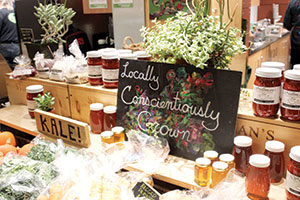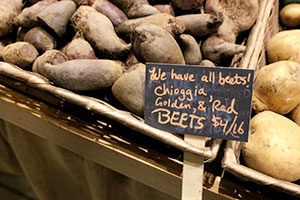
Winter farm stand at the Boston Public Market in Boston, MA.
By Margaux Maxwell
Local food movements have become increasingly popular across the country in recent years for a variety of environmental, ethical, nutritional and political reasons. Throughout Boston, varieties of fresh vegetables and fruits can be found at farmers markets from the heart of bustling Copley Square to residential Somerville to diverse communities such as Dorchester. But for many in New England, this type of direct action goes out the window when they hit New England’s perceived cold and barren winters.
“There’s nothing to eat around here in the winter,” says Rose Kary, 31, from Medford, as she strolls around Market Basket in Somerville, looking for some pineapples to roast this evening.
But local farmers beg to differ. A hearty, flavorful diet can be maintained on local vegetables, spices and dairy and meat products even in New England’s cold winters.
“Proof of that is that people were eating locally up until the 1950s. Of course, you have to make certain sacrifices for things that don’t grow in, say, January, but those are sacrifices you should make if you want to solve the water, labor and land management problems we have in this country,” says Kate Stillman, 35, of Stillman Farms in Lunenburg, MA.
One of her employees, Kat Lange, 22 from St. Paul, Massachusetts displays rows of winter baskets overflowing with macoun apples, watermelon radish, fingerling potatoes, red onions, golden beets, ruby red turnips, sweet potatoes, winter squash, and parsnips.

Root vegetables at Stillman’s Farm in February.
“While the harvesting season ends in September or October, roots like potatoes and beets can be kept in a cold root cellar, which is a dark, dry place where these veggies are stored to be eaten in winter. This is an old way to eat that can be built even in your basement. You can have food all winter long,” says Lange.
Lange says she makes mostly soups, stews and roasted veggies in the winter. Supplementary grains like wheat or legumes like beans can be sourced locally as well.
“Beans, like any seed, are easy to harvest in summer and left out to dry. No fancy equipment required, they don’t need to be dehydrated. Just leave them out and they will dry,” she says as she points to bags of dried black eyed peas, great northern beans, kidney beans and cranberry beans. Canned tomato sauce and pickles from August harvesting can also be found amongst the dried goods.
“We have technology on our side too in these days, and in local greenhouses you can supplement roots and beans with greens such as arugula, kale or spinach, but it is cost intensive because of what goes into maintaining a greenhouse. Arugula will be more expensive in the winter and people just have to accept the reality of that.” says Lange.
Casey Diedrich, 27, of Soluna Garden Farms, an herb farm in Winchester, MA, says there are many local fresh and dried herbs as well as oils and vinegars to be made and had in the wintertime.
“Hardy herbs like rosemary will last fresh indoors and then of course you can always dry herbs from the summer and use them all winter. Apple cider vinegar and things like that can easily be made and kept too from local apples, or sunflower seed oil from New England’s sunflowers,” says Diedrich.
For a little more flavor than just spice and oils, you can add a little richness to your meals with local cheese.

Shawn Cooney discussing his hydroponically grown lettuce varieties.
“In traditional milking schedules, you can milk cows all year round, pending they get pregnant, so you have a constant milk supply and age cheese any time. Our cheeses are anywhere from two weeks to fourteen months old and we age them in a cellar, though there are many varying ways and times and conditions in which you may want to age cheese. My favorite part about eating seasonal cheese is eating summer cheese that has been aged in the wintertime to get that grassy flavor even when there’s snow outside,” says Kara Chadborne of Jasper Hill Farms in Greensboro, Vermont.
Hydroponics, a method of growing plants indoors with artificial lighting in water as opposed to soil, may offer us a future option for more locally produced foods.
“In a controlled environment like hydroponics, you don’t run into the same problems that you do in a greenhouse like not having enough light to grow certain things. We can supply all the water and nutrients a lettuce might need for example and so that it won’t end up tasting like paper. With hydroponics, you could technically grow strawberries in winter, but it would be costly with all the electricity,” says Shawn Cooney, 63 of Corner Stalk Farm, a hydroponic farm that specializes in Controlled Environment Agriculture (CEA) in Boston, MA.
New England may appear to be a desolate place in January and February’s snowy days, but the possibility for abundance in the kitchen is still possible. Developments like hydroponics could mean even more locally grown food in the future of the local foods movement.















Reader Comments